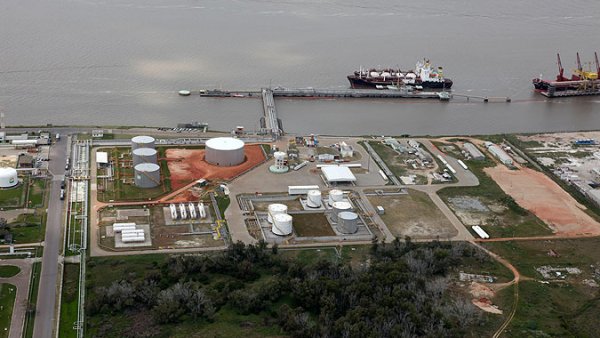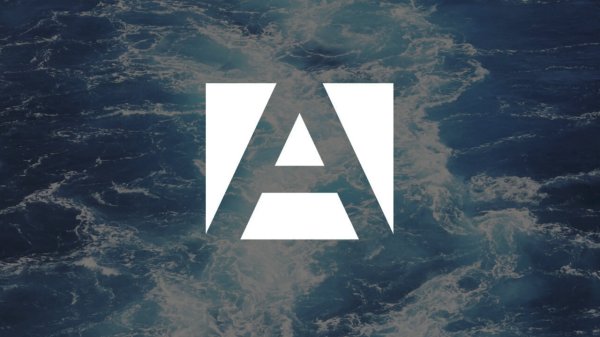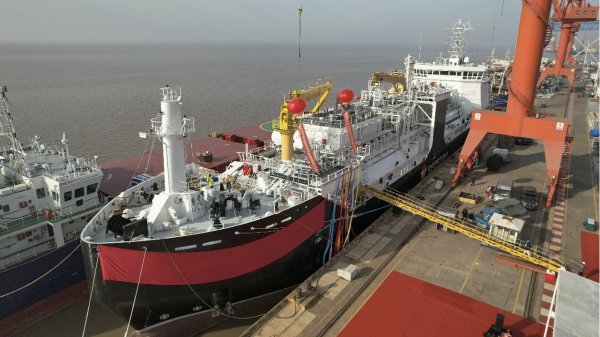DNVPS launches cat fine screening service
Service provides a particle size and quantity profile of catalyst fines in fuel.
DNV Petroleum Services (DNVPS) has today unveiled its advanced Catalyst Fine Particle Size Distribution Screening service, which will aim to complement its existing Fuel System Check programme.
Used in combination, the DNVPS Catalyst Fine Particle Size Distribution Screening and Fuel System Check provide a particle-size-and-quantity profile of catalyst fines in the fuel – before and after the separators.
The resulting data aims to provide a more accurate picture of the efficiency at which the fuel treatment plant is operating onboard the ship or at the power plant.
Composed of highly abrasive Aluminium and Silicon Oxides (Al+Si) and almost as hard as diamonds, catalyst fines are largely spherical particles originating from the catalytic cracking units in refineries. On entering the engine with the fuel, catalyst fine particles can quickly wear down piston rings, ring grooves, liners and fuel pumps if they exceed 5 microns in size and are present in sufficient quantities. Engine experts say particles in the 10-25 micron range are especially harmful to machinery components.
Up until now, commercial fuel system check services in the market focused on the quantities of catalyst fines remaining in the fuel after onboard purification. This is usually done by analyzing and comparing fuel samples taken before and after the separators in order to assess the overall efficiency levels of the fuel treatment plant.
Even as major engine makers commonly recommend a post-treatment catalyst fine content of no more than 15 ppm, there have been incidents where ships and power plants experienced anomalous component wear despite meeting this limit.
Such cases are one of the factors that have prompted the International Council on Combustion Engines (CIMAC) to consider a shift from focusing on fuel quality ‘as delivered’ to the ship or power plant, to fuel quality ‘at the engine inlet’. This proposal has found resonance among major engine makers, according to DNVPS managing director Tore Morten Wetterhus.
With two important fuel regulations implemented this year – the EU Directive 2005/33/EC 0.1% sulphur limit on Jan 1 and the MARPOL Annex VI 1.00% sulphur cap in the Emission Control Areas on Jul 1 – Mr Wetterhus says demand for low sulphur fuel is steadily rising, and this could in turn cause catalyst fine contents in blended products to increase.
Wetterhus says: “Residual fuels and particularly low sulphur products are made by blending residues with cutter stocks like cycle oil slurry, which may contain large quantities of catalyst fines. If the fuel treatment plant is not operating at an efficiency required to reduce the catalyst fines to safe levels before the fuel is consumed, the risk of increased engine wear and damage is very real.”
Describing how the damage may be inflicted, Mr Wetterhus says catalyst fine particles in the fuel may be forced into the running surfaces of cylinder liners and piston rings. These particles act like sandpaper on contact with the surfaces, escalating wear rates and hence shortening the time between overhaul. In severe cases, the resulting engine damages could compromise the safety of crew, cargo and carrier, Mr Wetterhus warns.
By coupling the new Catalyst Fine Particle Size Distribution Screening with DNVPS’ existing Fuel System Check programme, Mr Wetterhus says information on catalyst fine particle size and quantity will help the ship crew make more precise adjustments to improve the fuel treatment plant’s performance.
For example, the crew may be alerted to increase the centrifuge operating temperature or to change the throughput so as to better protect the engine from serious wear situations. In some cases, increased wear rates which Fuel System Check results attribute to insufficient fuel treatment efficiency, have led shipowners to replace old or under-sized separators with those of more recent design and larger capacity.
DNVPS says major ship owners like Odfjell and engine manufacturers such as MAN Diesel & Turbo are supporting DNVPS’ latest innovation through R&D collaborations.
MAN Diesel & Turbo senior engineer Henrik Rolsted says: “DNVPS’ introduction of a particle size screening service is very timely, given the fuel quality developments we are seeing today. As a preventive measure, it is prudent for ship operators to regularly monitor both the size and quantity of catalyst fines before the fuel is channelled into the ship engine.”
Used in combination, the DNVPS Catalyst Fine Particle Size Distribution Screening and Fuel System Check provide a particle-size-and-quantity profile of catalyst fines in the fuel – before and after the separators.
The resulting data aims to provide a more accurate picture of the efficiency at which the fuel treatment plant is operating onboard the ship or at the power plant.
Composed of highly abrasive Aluminium and Silicon Oxides (Al+Si) and almost as hard as diamonds, catalyst fines are largely spherical particles originating from the catalytic cracking units in refineries. On entering the engine with the fuel, catalyst fine particles can quickly wear down piston rings, ring grooves, liners and fuel pumps if they exceed 5 microns in size and are present in sufficient quantities. Engine experts say particles in the 10-25 micron range are especially harmful to machinery components.
Up until now, commercial fuel system check services in the market focused on the quantities of catalyst fines remaining in the fuel after onboard purification. This is usually done by analyzing and comparing fuel samples taken before and after the separators in order to assess the overall efficiency levels of the fuel treatment plant.
Even as major engine makers commonly recommend a post-treatment catalyst fine content of no more than 15 ppm, there have been incidents where ships and power plants experienced anomalous component wear despite meeting this limit.
Such cases are one of the factors that have prompted the International Council on Combustion Engines (CIMAC) to consider a shift from focusing on fuel quality ‘as delivered’ to the ship or power plant, to fuel quality ‘at the engine inlet’. This proposal has found resonance among major engine makers, according to DNVPS managing director Tore Morten Wetterhus.
With two important fuel regulations implemented this year – the EU Directive 2005/33/EC 0.1% sulphur limit on Jan 1 and the MARPOL Annex VI 1.00% sulphur cap in the Emission Control Areas on Jul 1 – Mr Wetterhus says demand for low sulphur fuel is steadily rising, and this could in turn cause catalyst fine contents in blended products to increase.
Wetterhus says: “Residual fuels and particularly low sulphur products are made by blending residues with cutter stocks like cycle oil slurry, which may contain large quantities of catalyst fines. If the fuel treatment plant is not operating at an efficiency required to reduce the catalyst fines to safe levels before the fuel is consumed, the risk of increased engine wear and damage is very real.”
Describing how the damage may be inflicted, Mr Wetterhus says catalyst fine particles in the fuel may be forced into the running surfaces of cylinder liners and piston rings. These particles act like sandpaper on contact with the surfaces, escalating wear rates and hence shortening the time between overhaul. In severe cases, the resulting engine damages could compromise the safety of crew, cargo and carrier, Mr Wetterhus warns.
By coupling the new Catalyst Fine Particle Size Distribution Screening with DNVPS’ existing Fuel System Check programme, Mr Wetterhus says information on catalyst fine particle size and quantity will help the ship crew make more precise adjustments to improve the fuel treatment plant’s performance.
For example, the crew may be alerted to increase the centrifuge operating temperature or to change the throughput so as to better protect the engine from serious wear situations. In some cases, increased wear rates which Fuel System Check results attribute to insufficient fuel treatment efficiency, have led shipowners to replace old or under-sized separators with those of more recent design and larger capacity.
DNVPS says major ship owners like Odfjell and engine manufacturers such as MAN Diesel & Turbo are supporting DNVPS’ latest innovation through R&D collaborations.
MAN Diesel & Turbo senior engineer Henrik Rolsted says: “DNVPS’ introduction of a particle size screening service is very timely, given the fuel quality developments we are seeing today. As a preventive measure, it is prudent for ship operators to regularly monitor both the size and quantity of catalyst fines before the fuel is channelled into the ship engine.”

|
IMO approves pricing mechanism based on GHG intensity thresholds
Charges to be levied on ships that do not meet yearly GHG fuel intensity reduction targets. |
|
|
|
||

|
VARO Energy expands renewable portfolio with Preem acquisition
All-cash transaction expected to complete in the latter half of 2025. |
|
|
|
||

|
NYK trials biofuel in milestone coal carrier test
Vessel is used to test biofuel for domestic utility company. |
|
|
|
||

|
H-Line Shipping orders LNG bunkering vessel
Vessel with 18,000-cbm capacity to run on both LNG and MDO. |
|
|
|
||

|
How to engineer and manage green shipping fuels | Stanley George, VPS
Effective management strategies and insights for evolving fuel use. |
|
|
|
||

|
Swedish government bans scrubber wastewater discharges
Discharges from open-loop scrubbers to be prohibited in Swedish waters from July 2025. |
|
|
|
||

|
MAN Energy Solutions achieves 100% load milestone for ammonia engine
Latest tests validate fuel injection system throughout the entire load curve. |
|
|
|
||

|
Petrobras secures ISCC EU RED certification for B24 biofuel blend at Rio Grande
Blend consisting of 24% FAME is said to have been rigorously tested to meet international standards. |
|
|
|
||

|
Stolt-Nielsen to fully control Avenir LNG with acquisition
Share purchase agreement to buy all shares from Golar LNG and Aequitas. |
|
|
|
||

|
Bureau Veritas supports launch of CIMC SOE's LNG bunkering vessel
Handover of Seaspan Energy's cutting-edge 7,600-cbm vessel completed. |
|
|
|
||
Related Links
- · DNVPS appoints global sales manager [Insights]
- · Fuel quality data service unveiled [Insights]
- · Fuel quality warning in US Gulf [Insights]

